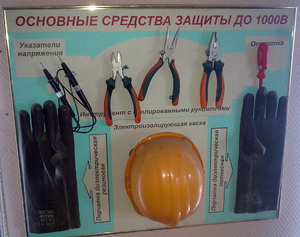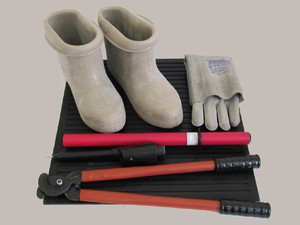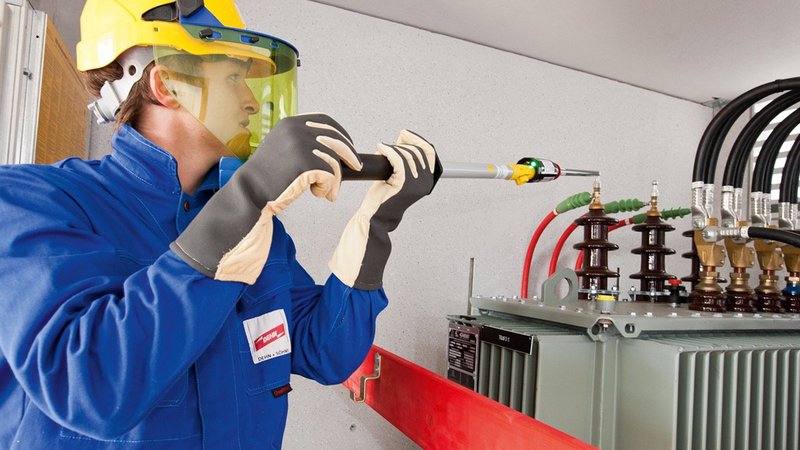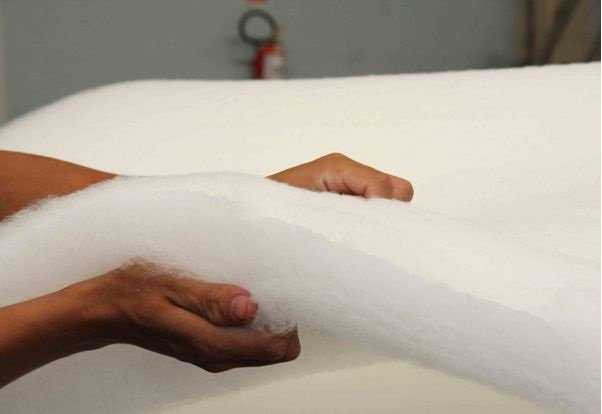How are electrical protective equipment subdivided: detailed characteristics
Electrical protective means are meant, the use of which reduces or prevents the exposure of workers to hazardous factors of production. By the nature of their use, electrical protective equipment is divided into devices for personal or collective protection. Structural elements of an electrical installation (grounding knives, fences) that perform a protective function are not included here.
General information
Electrical protective equipment is transportable or portable equipment that serves to protect workers from exposure to electromagnetic fields, electric arcs and electric shocks. Electrical protective equipment is subdivided into auxiliary and basic.
To general electrical protective equipment relate:

In addition, you can use personal protection: helmets, goggles, gloves, gas masks, a safety rope and a mounting belt.
Basic fixtures
 The main ones are the means in which the insulation can withstand the voltage of the electrical installation for a long time, as well as those devices that make it possible to touch the current-carrying elements. They are tested under voltage taking into account the respective installation in which they are used.
The main ones are the means in which the insulation can withstand the voltage of the electrical installation for a long time, as well as those devices that make it possible to touch the current-carrying elements. They are tested under voltage taking into account the respective installation in which they are used.
The main devices for working with a voltage of more than 1000 volts include: measuring clamps, rods, insulating means (platforms, ladders, cables, rods). The main protective devices in installations up to 1000 volts are rods, insulating pliers, gloves, locksmith tools with insulating handles and voltage indicators.
Insulating elements must be made of materials with a stable dielectric coefficient (ebonite, porcelain, plastic, getinax).
Materials that absorb moisture (for example, wood) must be covered with a moisture-resistant compound and have a surface without scratches, peeling and splitting.
Additional devices
Accessories supplement the basic equipment, and are also required for protection against touch voltage and cannot independently protect against electric shock. For electrical installations over 1000 volts apply:

Accessories in installations up to 1000 volts include portable grounding, dielectric rugs and galoshes, safety signs, enclosing structures, insulating gaskets.
Picking methods
Workers serving electrical installations must be equipped with electrical protective equipment that ensures safety. All funds must be in the inventory in the shops of power plants and switchgears, at transformer stations and substations, or may be in the inventory of mobile laboratories, operational or centralized repair teams.
Inventory is distributed between facilities and repair teams, taking into account the operational management system, picking rules and local requirements. This equipment must be recorded in the lists, which are approved by the chief engineer of the organization.

Responsibility for providing electrical installations with tested means, performing inspections, creating a reserve and organizing storage, replenishing stock, disposing of unusable devices is borne by the site master, the head of the power grid, substation, workshop, under whose control the corresponding electrical installations are located, and in general for the organization - the chief engineer ... Workers who received funds for individual use are obliged to be responsible for their correct operation and timely disposal.
During the determination of the unsuitability of the funds that were received for a separate electrical installation, employees are obliged to immediately withdraw them, notifying the chief who is responsible for the inventory, and make a corresponding entry in the operational documentation or in the accounting book.
Storage features
All protective devices that are in operation and in reserve must be stored and transported with the condition of ensuring their working condition and suitability for use without preliminary restoration work. Therefore, the funds are required to protect themselves from deformation, dirt and moisture:

Condition monitoring and accounting
 All operated electrical protective devices and mounting belts must be numbered (except for stands, rugs, safety signs). Numbering is performed at the substation or electrical network separately for all types of electrical protective equipment. If the device has several elements, then the number must be indicated on all parts.
All operated electrical protective devices and mounting belts must be numbered (except for stands, rugs, safety signs). Numbering is performed at the substation or electrical network separately for all types of electrical protective equipment. If the device has several elements, then the number must be indicated on all parts.
At the substation, in the workshops of the power plant, in the laboratories, it is necessary to keep books of content and accounting, which indicate the numbers, names, dates of regular tests and inspections, and the location. The devices that are in individual use are also described in the book with the date and time of issue, as well as the signature of the employee who received them.
During operation, protective equipment must be subjected to periodic acceptance tests. The test results must be recorded in the book of the laboratory that performed them. The book keeping pattern is not regulated.
After testing, a special stamp is installed on all means. He must be clearly visible. The stamp is either applied with paint, or knocked out, or glued to the insulating area. If the fixture has several elements, then the stamp is installed on only one part. On the means of electrical protection, which were found to be faulty during testing, the stamp is crossed out with red paint.
Operating rules
It is necessary to use insulating means only taking into account their direct purpose with a voltage not exceeding that for which the device is designed.
Fixed assets can be used in open or closed systems, as well as on overhead transmission lines, exclusively in dry weather. It is forbidden to use them in wet weather. For open distribution systems in wet weather, special devices are used that have been developed for this purpose. Operation, testing and manufacturing of these tools must be carried out taking into account GOST, instructions and technical conditions.

Before any use of protective equipment employees should:
- determine by the stamp for what voltage this device is used and whether the test period is over;
- check the serviceability, and also clean and dust off the protective agent. Rubber products are checked for punctures.
The use of electrical protective equipment that has expired the test period is prohibited, since they are unsuitable.
Varieties of tests
After manufacture, protective devices shall be subjected to type and routine tests. The main types of tests:

Classification of posters
Taking into account the main purpose, posters are divided into the following main groups: prohibiting, warning, indicative and prescriptive. According to the method of use, they can be portable and permanent.
Portable posters are made of plastic, wood, or cardboard. The permanent ones are made from sheet steel, plastic materials, or by applying paint to various surfaces through a stencil. For outdoor switchgear, posters with various devices (hooks, clamp, cable) can be made for their fastening at the installation site.
Warning Posters Required:

Every person who works with electricity must certainly be equipped with the necessary electrical protection equipment, taking into account the type of work. It should be remembered that all inventory must be inspected under voltage before starting to operate.
Before any work, it is imperative to check the tool for faults.
- Rules for the use of electrical protective equipment when carrying out work in electrical installations
- How to sew fleece mittens
- Protective equipment in electrical installations
- Computer glasses: which is better to choose
- How to wash clothes with Thinsulate insulation
- Training in electrical safety, labor protection, ecology, electrical safety, fire-technical minimum, first aid to victims of the courses
- Protective equipment in electrical installations up to and above 1000 Volts
- What is fleece fabric, where is it used and how to care for it
- Personal protective equipment
- What is this fabric?
- Thinsulate
- Exercise with walnuts exercises the brain and slows down aging Exercise with nuts for the hands
- Feng Shui talismans Feng Shui souvenirs meaning
- Feng Shui symbols for monetary luck, career, love. Feng Shui talismans of good luck
- Traditions of the Russian feast - abstract Russian feast customs and traditions
- Living without food Let's talk about non-food and our knowledge of the body
- People who live without food and water (sun eaters): myth or reality?
- Tursunov dmitry tennis. "If you want, hit me!" How Tursunov helped Arina Sobolenko win the first title. Why did your father want to make you a tennis player?
- Weaving willow baskets: technology, materials, tips for beginners
- Good morning and good day wishes









